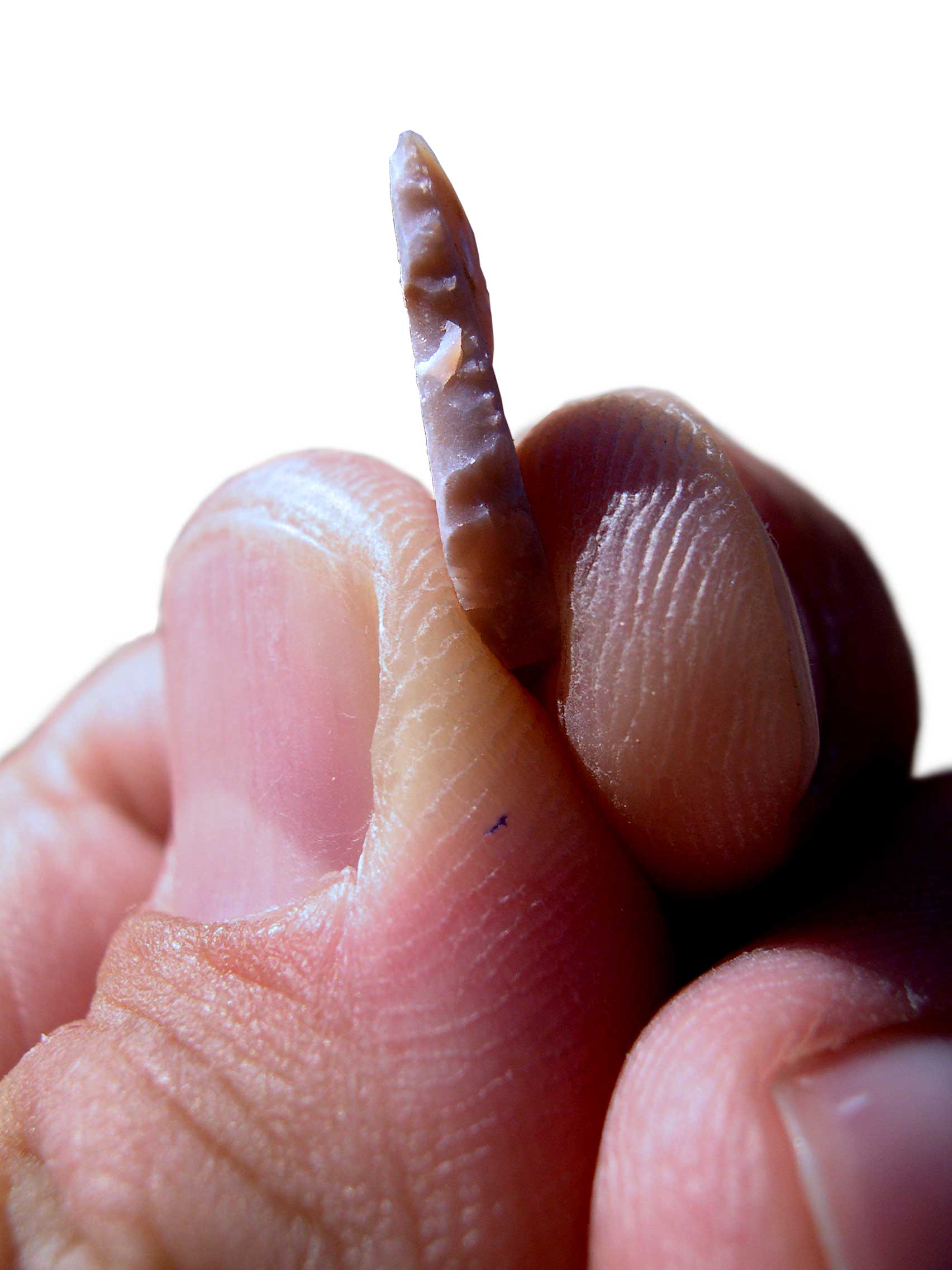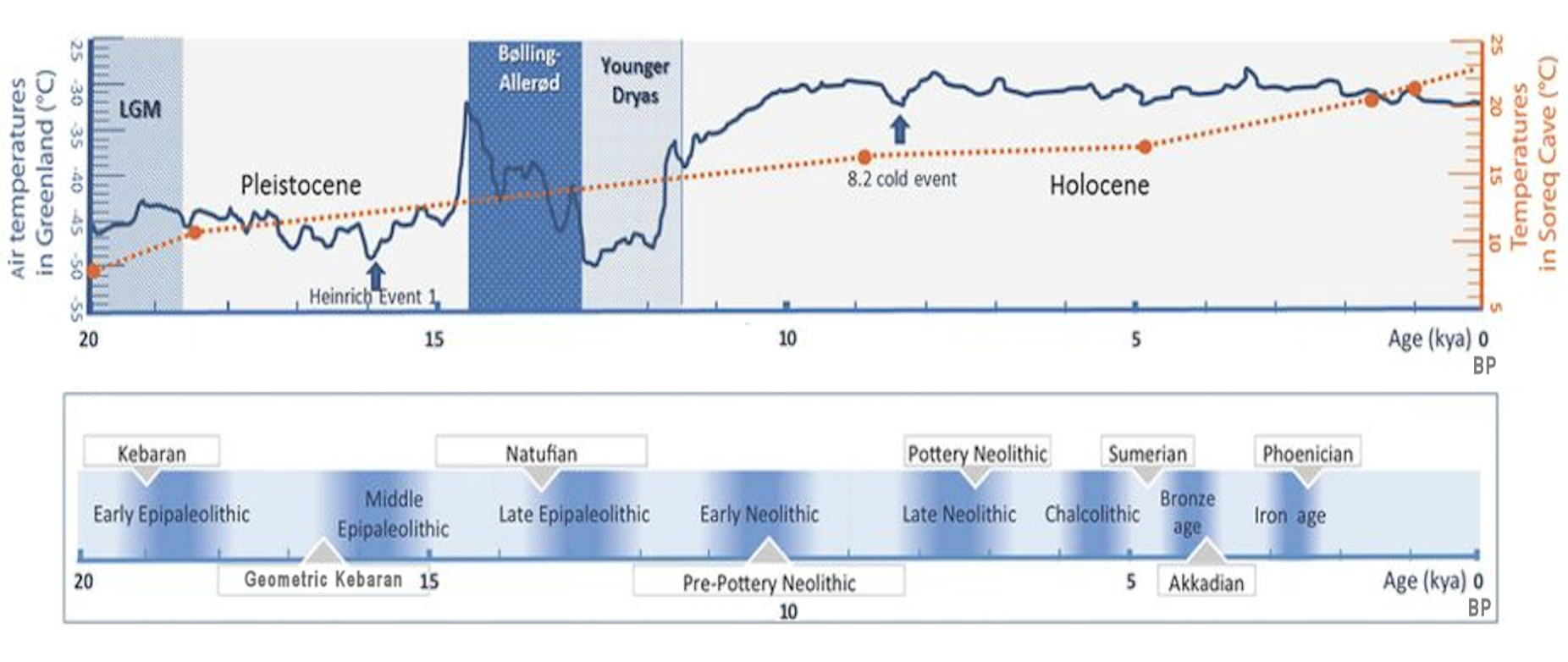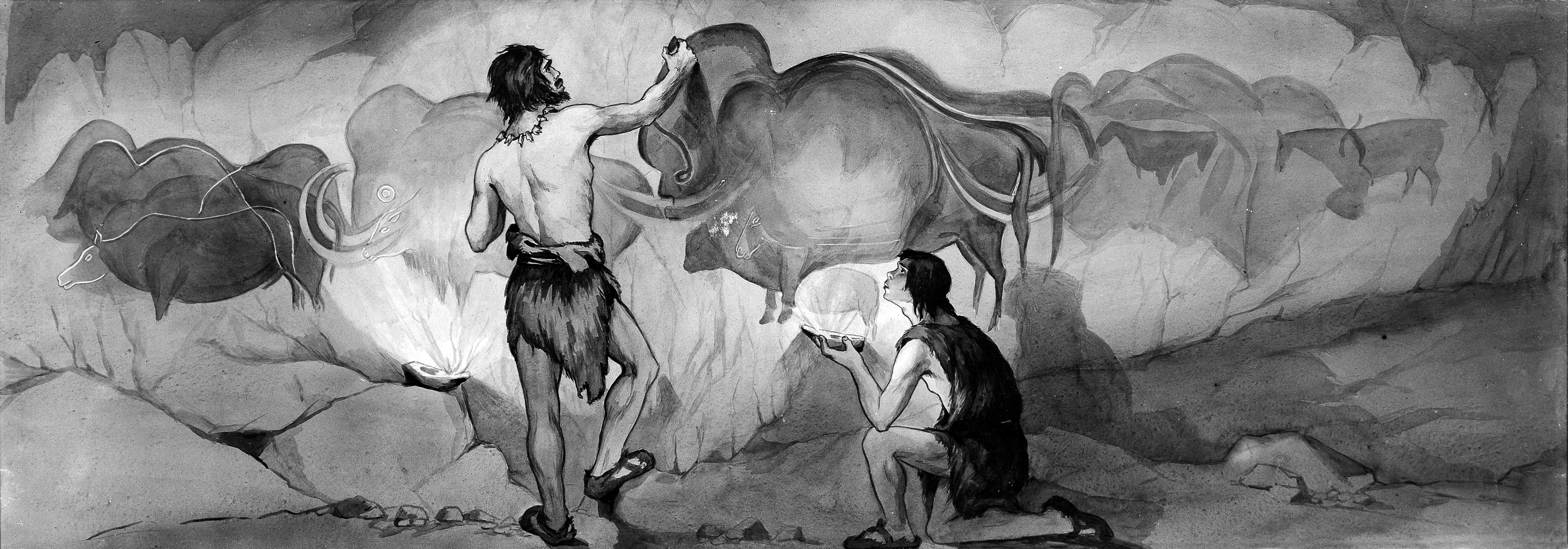|
Microlith
A microlith is a small stone tool usually made of flint or chert and typically a centimetre or so in length and half a centimetre wide. They were made by humans from around 35,000 to 3,000 years ago, across Europe, Africa, Asia and Australia. The microliths were used in spear points and arrowheads. Microliths are produced from either a small blade ( microblade) or a larger blade-like piece of flint by abrupt or truncated retouching, which leaves a very typical piece of waste, called a microburin. The microliths themselves are sufficiently worked so as to be distinguishable from workshop waste or accidents. Two families of microliths are usually defined: laminar and geometric. An assemblage of microliths can be used to date an archeological site. Laminar microliths are slightly larger, and are associated with the end of the Upper Paleolithic and the beginning of the Epipaleolithic era; geometric microliths are characteristic of the Mesolithic and the Neolithic. Geometric microlit ... [...More Info...] [...Related Items...] OR: [Wikipedia] [Google] [Baidu] |
Microlith In Hand
A microlith is a small stone tool usually made of flint or chert and typically a centimetre or so in length and half a centimetre wide. They were made by humans from around 35,000 to 3,000 years ago, across Europe, Africa, Asia and Australia. The microliths were used in spear points and arrowheads. Microliths are produced from either a small blade ( microblade) or a larger blade-like piece of flint by abrupt or truncated retouching, which leaves a very typical piece of waste, called a microburin. The microliths themselves are sufficiently worked so as to be distinguishable from workshop waste or accidents. Two families of microliths are usually defined: laminar and geometric. An assemblage of microliths can be used to date an archeological site. Laminar microliths are slightly larger, and are associated with the end of the Upper Paleolithic and the beginning of the Epipaleolithic era; geometric microliths are characteristic of the Mesolithic and the Neolithic. Geometric microli ... [...More Info...] [...Related Items...] OR: [Wikipedia] [Google] [Baidu] |
Kebaran Culture
The Kebaran culture, also known as the Early Near East Epipalaeolithic, was an archaeological culture in the Eastern Mediterranean area (c. 23,000 to 15,000 BP), named after its type site, Kebara Cave south of Haifa. The Kebaran were a highly mobile nomadic population, composed of hunters and gatherers in the Levant and Sinai areas who used microlithic tools. Overview The Kebaran is the last Upper Paleolithic phase of the Levant. Kebaran stone tool assemblages are characterized by small, geometric microliths, and are thought to have lacked the specialized grinders and pounders found in later Near Eastern cultures. Small stone tools called microliths and retouched bladelets can be found for the first time. The microliths of this culture period differ greatly from the Aurignacian artifacts. The Kebaran is preceded by the Athlitian phase of the Upper Paleolithic Levantine Aurignacian (formerly called Antelian) and followed by the proto-agrarian Natufian culture of the Epip ... [...More Info...] [...Related Items...] OR: [Wikipedia] [Google] [Baidu] |
Microburin
A microburin is a characteristic waste product from manufacture of lithic tools — sometimes confused with an authentic burin — which is characteristic of the Mesolithic, but which has been recorded from the end of the Upper Paleolithic until the Chalcolithic. This type of lithic artifact was first named by Henri Breuil who defined it as "a type of angular, smooth, with a terminal retouch in the form of a small notch". Breuil initially thought that the microburins had a functional use as a type of microlithic burin. However, he later came to realize that the manufacturing technique was different from that of the burin and that they could be waste products from the manufacture of microliths, but they may have occasionally been reused for a useful purpose, which is expected for parsimonious lithic resource exploitation A microburin is a fragment of a lithic flake, or more precisely, of a lithic blade, that shows on its upper face the beginnings of a notch terminating in an obliqu ... [...More Info...] [...Related Items...] OR: [Wikipedia] [Google] [Baidu] |
Magdalenian
The Magdalenian cultures (also Madelenian; French: ''Magdalénien'') are later cultures of the Upper Paleolithic and Mesolithic in western Europe. They date from around 17,000 to 12,000 years ago. It is named after the type site of La Madeleine, a rock shelter located in the Vézère valley, commune of Tursac, in France's Dordogne department. Édouard Lartet and Henry Christy originally termed the period ''L'âge du renne'' (the Age of the Reindeer). They conducted the first systematic excavations of the type site, publishing in 1875. The Magdalenian epoch is associated with reindeer hunters, although Magdalenian sites contain extensive evidence for the hunting of red deer, horses, and other large mammals present in Europe toward the end of the last glacial period. The culture was geographically widespread, and later Magdalenian sites stretched from Portugal in the west to Poland in the east, and as far north as France, the Channel Islands, England, and Wales. It is the th ... [...More Info...] [...Related Items...] OR: [Wikipedia] [Google] [Baidu] |
Mesolithic
The Mesolithic (Greek: μέσος, ''mesos'' 'middle' + λίθος, ''lithos'' 'stone') or Middle Stone Age is the Old World archaeological period between the Upper Paleolithic and the Neolithic. The term Epipaleolithic is often used synonymously, especially for outside northern Europe, and for the corresponding period in the Levant and Caucasus. The Mesolithic has different time spans in different parts of Eurasia. It refers to the final period of hunter-gatherer cultures in Europe and Western Asia, between the end of the Last Glacial Maximum and the Neolithic Revolution. In Europe it spans roughly 15,000 to 5,000 BP; in Southwest Asia (the Epipalaeolithic Near East) roughly 20,000 to 10,000 BP. The term is less used of areas farther east, and not at all beyond Eurasia and North Africa. The type of culture associated with the Mesolithic varies between areas, but it is associated with a decline in the group hunting of large animals in favour of a broader hunt ... [...More Info...] [...Related Items...] OR: [Wikipedia] [Google] [Baidu] |
Lunate
Lunate is a crescent or moon-shaped microlith. In the specialized terminology of lithic reduction, a lunate flake is a small, crescent-shaped flake removed from a stone tool during the process of pressure flaking. In the Natufian period, a lunate was a small crescent-shaped stone tool that was sometimes used to harvest grasses. In archaeology a lunate is a small stone artifact, that has a sharpened straight edge and a blunt crescent shaped back. The word originates from the Latin word lunatus which means to bend like a crescent, and from luna meaning moon in Latin. A lunate object can be typically used as a decorative piece or as a stone tool. Israeli lunate In the earlier findings of Epipaleolithic lunate in the Natufian, Harifian, and Negev Kebaran periods in Israel they were roughly 10–40 mm long and were formed on small blades or bladelets. While the later findings Natufian and Harifian range of lengths varied then from 9–17 mm. In the later period the ... [...More Info...] [...Related Items...] OR: [Wikipedia] [Google] [Baidu] |
Tardenoisian
The Tardenoisian (or Beuronian) is an archaeological culture of the Mesolithic/Epipaleolithic period from northern France and Belgium. Similar cultures are known further east in central Europe, parts of Britain. and west across Spain. It is named after the type site at Fère-en-Tardenois in the Tardenois region in France, where E. Taté first discovered its characteristic artifacts in 1885. Characteristic artifacts differ from earlier industries by the presence of geometric microliths, microburin, scalene triangles, trapezoids and chisel-ended arrowheads and small flint blades made by the pressure-technique. The term is also used for several microlithic industries and sites in northern Italy and Eastern Europe and to distinguish the northern French Tardenoisian sites from the Sauveterrian industry in southern France. The Tardenoisian followed the Ahrensburgian, with which it was paralleled, and lasted from about 9.000 BC until 6.000 in the Neolithic The Neolithic period ... [...More Info...] [...Related Items...] OR: [Wikipedia] [Google] [Baidu] |
Ibero-Maurusian
The Iberomaurusian is a backed bladelet lithic industry found near the coasts of Morocco, Algeria, and Tunisia. It is also known from a single major site in Libya, the Haua Fteah, where the industry is locally known as the Eastern Oranian.The "Western Oranian" would refer to the Iberomaurusian in Morocco, Algeria, and Tunisia, but this expression is seldom used. The Iberomaurusian seems to have appeared around the time of the Last Glacial Maximum (LGM), somewhere between c. 25,000 and 23,000 cal BP. It would have lasted until the early Holocene c. 11,000 cal BP. The name of the Iberomaurusian means "of Iberia and Mauretania", the latter being a Latin name for Northwest Africa. Pallary (1909) coined this termPallary, P., 1909. Instructions pour la recherche préhistorique dans le Nord-Ouest de l'Afrique, Algiers. to describe assemblages from the site of La Mouillah in the belief that the industry extended over the strait of Gibraltar into the Iberian peninsula. This theory is now ... [...More Info...] [...Related Items...] OR: [Wikipedia] [Google] [Baidu] |
Epipaleolithic
In archaeology, the Epipalaeolithic or Epipaleolithic (sometimes Epi-paleolithic etc.) is a period occurring between the Upper Paleolithic and Neolithic during the Stone Age. Mesolithic also falls between these two periods, and the two are sometimes confused or used as synonyms. More often, they are distinct, referring to approximately the same period of time in different geographic areas. Epipaleolithic always includes this period in the Levant and, often, the rest of the Near East. It sometimes includes parts of Southeast Europe, where Mesolithic is much more commonly used. Mesolithic very rarely includes the Levant or the Near East; in Europe, Epipalaeolithic is used, though not very often, to refer to the early Mesolithic. The Epipalaeolithic has been defined as the "final Upper Palaeolithic industries occurring at the end of the final glaciation which appear to merge technologically into the Mesolithic". The period is generally dated from BP to 10,000 BP ... [...More Info...] [...Related Items...] OR: [Wikipedia] [Google] [Baidu] |
Prepared Core
The prepared-core technique is a means of producing stone tools by first preparing common stone cores into shapes that lend themselves to knapping off flakes that closely resemble the desired tool and require only minor touch-ups to be usable. In contrast to the production of core tools like handaxes, where cores themselves were the end product shaped and trimmed down by removal of flakes, in prepared-core technique large flakes are the product and the core is used to produce them. This shift made it faster and more resource-efficient, as multiple tools could be struck from a single piece of starting material. Prepared core preparation techniques are grouped under the label Mode 3 technology. The best-known prepared core reduction method is the Levallois technique Prepared core technology was likely invented independently multiple times at different locations. The regular use of Prepared core technology is associated with large-brained hominins such as ''Homo heidelbergensis' ... [...More Info...] [...Related Items...] OR: [Wikipedia] [Google] [Baidu] |
Aurignacian
The Aurignacian () is an archaeological industry of the Upper Paleolithic associated with European early modern humans (EEMH) lasting from 43,000 to 26,000 years ago. The Upper Paleolithic developed in Europe some time after the Levant, where the Emiran period and the Ahmarian period form the first periods of the Upper Paleolithic, corresponding to the first stages of the expansion of ''Homo sapiens'' out of Africa. They then migrated to Europe and created the first European culture of modern humans, the Aurignacian. An Early Aurignacian or Proto-Aurignacian stage is dated between about 43,000 and 37,000 years ago. The Aurignacian proper lasts from about 37,000 to 33,000 years ago. A Late Aurignacian phase transitional with the Gravettian dates to about 33,000 to 26,000 years ago. The type site is the Cave of Aurignac, Haute-Garonne, south-west France. The main preceding period is the Mousterian of the '' Neanderthals''. One of the oldest examples of figurative art, the V ... [...More Info...] [...Related Items...] OR: [Wikipedia] [Google] [Baidu] |
"Noailles" Burin
Burin from the Upper Paleolithic (Gravettian) (ca. 29,000–22,000 BP) In the field of lithic reduction, a burin (from the French ''burin'', meaning "cold chisel" or modern engraving burin) is a type of handheld lithic flake with a chisel-like edge which prehistoric humans used for engraving or for carving wood or bone. In archaeology, burin use is often associated with "burin spalls", which are a form of debitage created when toolmakers strike a small flake obliquely from the edge of the burin flake in order to form the graving edge. Documented use left, 180px, Carinated "burin"/microblade core with multiple facets Standardized burin usage is typical of the Middle Paleolithic and Upper Palaeolithic cultures in Europe, but archaeologists have also identified them in North American cultural assemblages, and in his book ''Early Man in China'', Jia Lanpo of Beijing University lists dihedral burins and burins for truncation among artifacts uncovered along the banks of the L ... [...More Info...] [...Related Items...] OR: [Wikipedia] [Google] [Baidu] |






.jpg)